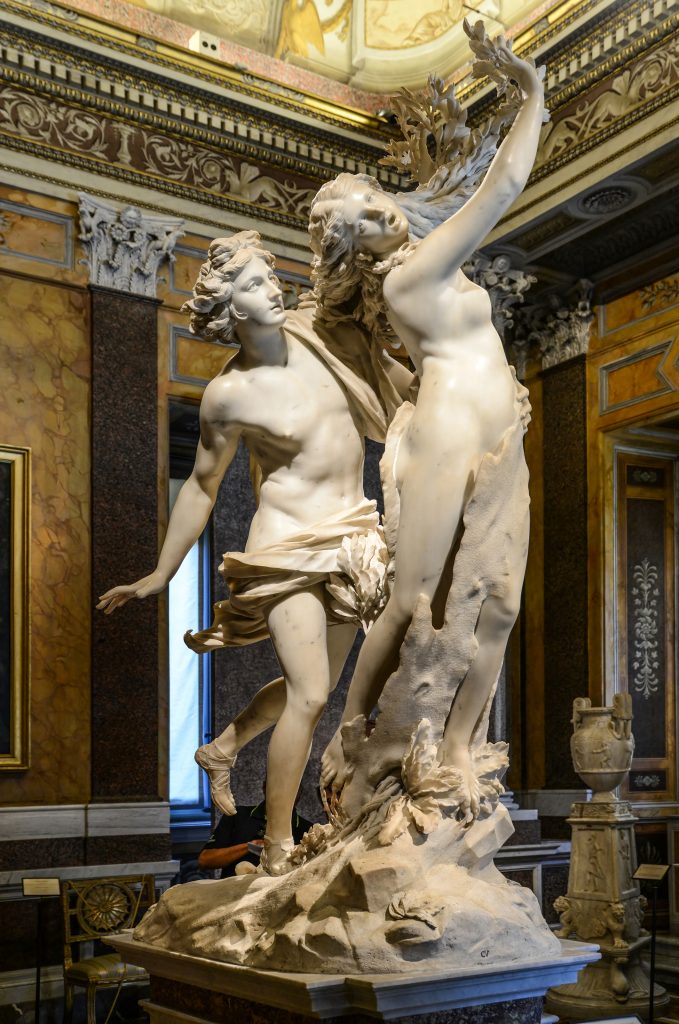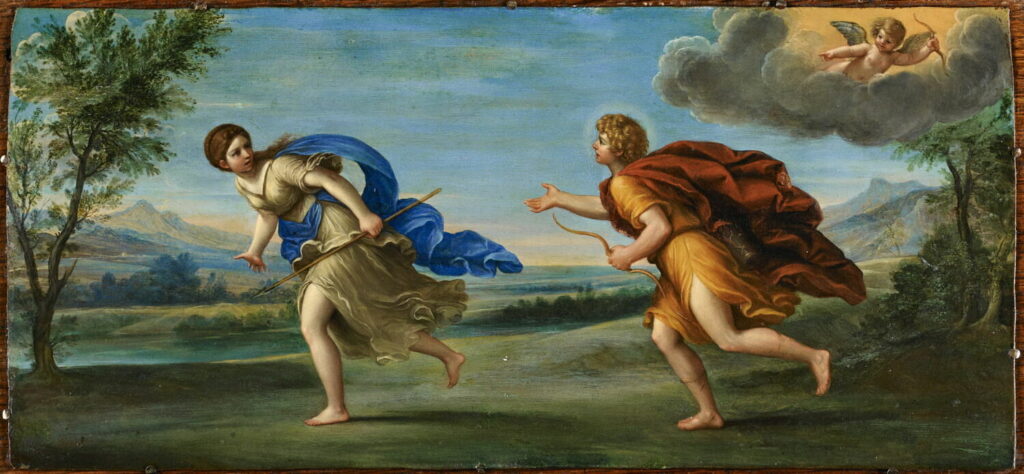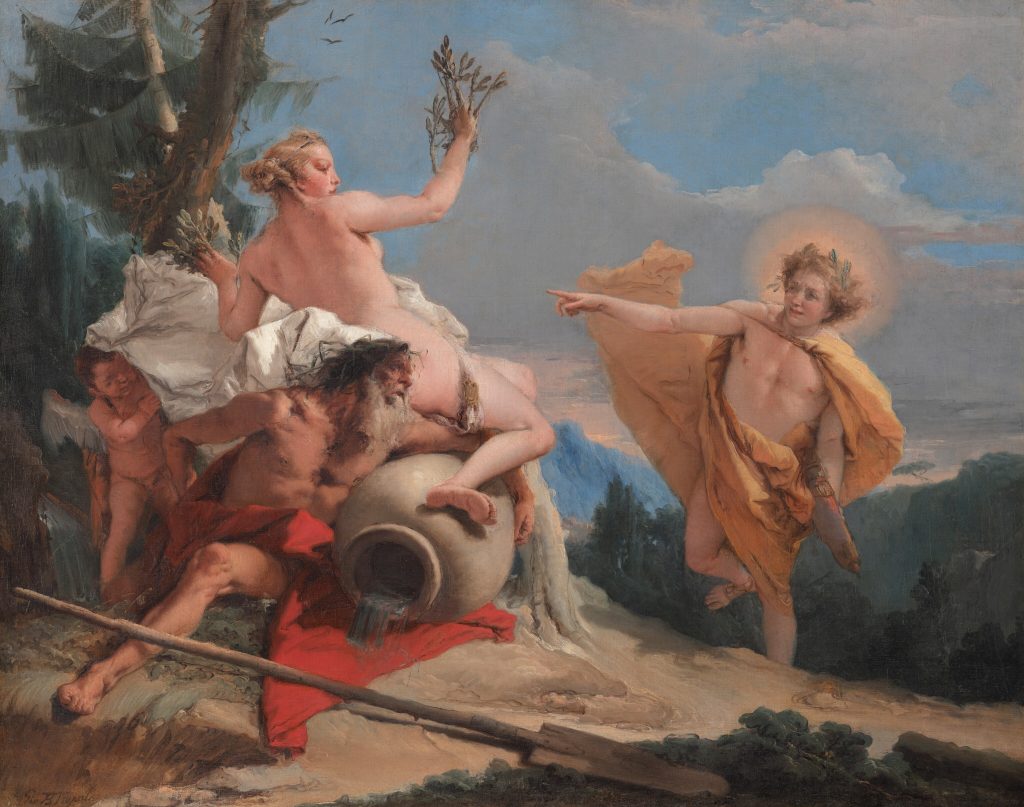Winter Through Pieter Bruegel’s Eyes
Nature is ever-present in Pieter Bruegel the Elder’s work. As seasons change, the painter captures nature’s subtle details. Among them,...
Javier Abel Miguel 13 January 2025
From Ancient Rome to the Renaissance and Rococo, the timeless appeal of the Apollo and Daphne myth spans centuries of artistic expression. The myth of Apollo and Daphne is one of the most enduring tales from Greek mythology. It has been depicted in various famous works, symbolizing themes of unrequited love, transformation, and the tension between human desire and divine will.
The story of Apollo and Daphne belongs to Ancient Greek and Roman myth, and derives from the mythological tale of Ovid’s Metamorphoses. It is likely of Hellenistic origin as no written versions of the myth survived from ancient Greece. Roman authors retold it as an amorous vignette. In the most well-known, which is Ovid’s version of the story, Apollo, struck by Cupid’s arrow, falls in love with the nymph Daphne. As Apollo chases her, Daphne calls for help from her father, the river god Peneus, who transforms her into a laurel tree. This way she escapes Apollo’s advances.

Apollo and Daphne, c. 62–79 CE, fresco from south wall of Casa dell’Efebo bedroom, Pompeii, Italy. Wikimedia Commons (public domain).
The Roman fresco of Apollo and Daphne offers a symbolic interpretation within the context of Roman art and culture. The fresco illustrates Apollo’s pursuit of Daphne, who is ultimately transformed into a laurel tree. This scene, painted in the lavish setting of an upper-class Roman home, carries several layers of symbolism.
The fresco highlights the tension between Apollo, the powerful god of the sun and of prophecy, and Daphne, a mortal who seeks autonomy from his pursuit. Apollo’s longing symbolizes unbridled passion and divine power, while Daphne’s transformation represents human resistance and the desire to preserve one’s identity and will. This opposition explores the balance between power, desire, and personal agency.

Piero del Pollaiolo, Apollo and Daphne, 1470–1480, National Gallery, London, UK.
Moving on to the Renaissance, the painting of Apollo and Daphne, attributed to Piero del Pollaiuolo, is an important Renaissance work that visually interprets the famous myth from Ovid’s Metamorphoses. While not as renowned as Bernini’s sculpture, which you will see in a moment, it holds historical significance as an example of early Renaissance interpretations of classical mythology.
The composition of the painting is dynamic, reflecting the mythological narrative. In the foreground, Apollo is depicted in a highly animated pose as he pursues the fleeing nymph, Daphne. Daphne is captured mid-transformation, with her arms and body beginning to change into branches and leaves. This visual represents the moment she turns into a tree.
The figures are portrayed with exaggerated musculature and realistic anatomical precision, which is typical of Pollaiuolo’s style. They are dynamic and expressive, capturing the tension of the myth. The narrative moment captured by the artist is one of transformation and escape. Unlike other, more serene or static depictions of the myth, his version focuses on the energy and tension of the chase.

Gian Lorenzo Bernini, Apollo and Daphne, 1622–1625, Galleria Borghese, Rome, Italy. Photograph by Alvesgaspar via Wikimedia Commons (CC BY-SA 4.0).
Gian Lorenzo Bernini’s renowned Baroque sculpture Apollo and Daphne captures the moment of transformation in exquisite detail. As Apollo reaches for the fleeing Daphne, her body turns into a laurel tree. Bernini masterfully conveys the sense of motion and anguish. He does this with Daphne’s limbs and face transforming into bark and leaves while Apollo’s outstretched hand is frozen in an eternal pursuit.
This work embodies the dramatic intensity of the myth, with both the divine passion of Apollo and Daphne’s desperate escape rendered in marble.

Francesco Albani, Apollo and Daphne, 1615–1620, Louvre, Paris, France.
In this Baroque painting, Albani portrays the dramatic moment when Daphne begins her transformation. Apollo is shown in pursuit, reaching out to grasp her. The energy of the scene is captured in the dynamic movement of the figures and the fluidity of the transformation. Albani was inspired by classical art but added vibrant colors and contrasting light to highlight the drama of the scene. His technique of using soft brushstrokes for the figures only exemplifies the intense emotion of the narrative.
This painting is a perfect example of Baroque fascination with emotion and the human form. Generations later, artists are still drawn to this particular Baroque example of Apollo and Daphne.

Giovanni Battista Tiepolo, Apollo Pursuing Daphne, c. 1755–1760, National Gallery of Art, Washington, DC, USA.
The final example of Apollo and Daphne in art is from the 18th century. Tiepolo’s Apollo Pursuing Daphne, an excellent example of Venetian Rococo style, is known for its dramatic flair, rich colors, and mythological themes. As you can see in the painting, it depicts the mythological story from Ovid’s Metamorphoses.
The painting exemplifies the Venetian Rococo style with its playful yet dramatic narrative, delicate figures, and vibrant color palette. Tiepolo’s characteristic use of soft pastels and his expertise in light and shadow is evident in the ethereal rendering of Daphne’s form and the celestial glow around Apollo. This masterpiece is held at the National Gallery of Art in Washington, DC, and is considered one of the museum’s highlights of their Rococo collection.
DailyArt Magazine needs your support. Every contribution, however big or small, is very valuable for our future. Thanks to it, we will be able to sustain and grow the Magazine. Thank you for your help!